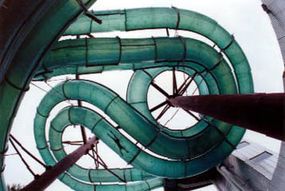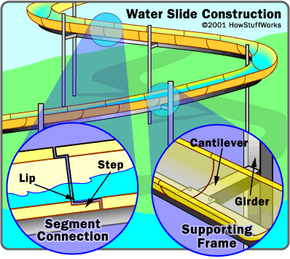Waterslide Construction: Bits and Pieces
A small waterslide, the sort you might find in somebody's backyard, has a very simple construction. It's a single piece of smooth fiberglass material, cast in the shape of a slide, supported by a metal frame.
Most water park slides have a similar structure, but on a much larger scale. Obviously, it's not feasible to use a single piece of fiberglass for a giant, curving slide. Water park slides are formed from dozens of fiberglass segments fastened together with heavy-duty bolts. Typically, the individual segments fit together like sections of a toy race track.
Advertisement
Each segment has one end with a raised lip and one end with a sunken step. When you fit two segments together, the lip of segment A rests on the step of segment B. This ensures that the segments hold together, with a smooth seam between them. Ideally, the slide feels like a single unit to the rider. Slides typically use completely enclosed tubes for the sharpest turns, to make sure everyone stays in.

These segments rest on a framework of steel girders. The girders may be positioned directly below the slide, or they may sit adjacent to the slide, supporting it with sturdy cantilevers.
Water parks generally buy new slides from an outside manufacturer. The manufacturer designs the slide and builds the individual pieces. The water park hires a local contractor to take these pieces and put the slide together according to the manufacturer's directions. It's just like building a toy race track or model train but on a massive scale. The actual slide structure is only half of the ride, of course. Next, we'll take a look at how water lets you slip from the top to the bottom.
